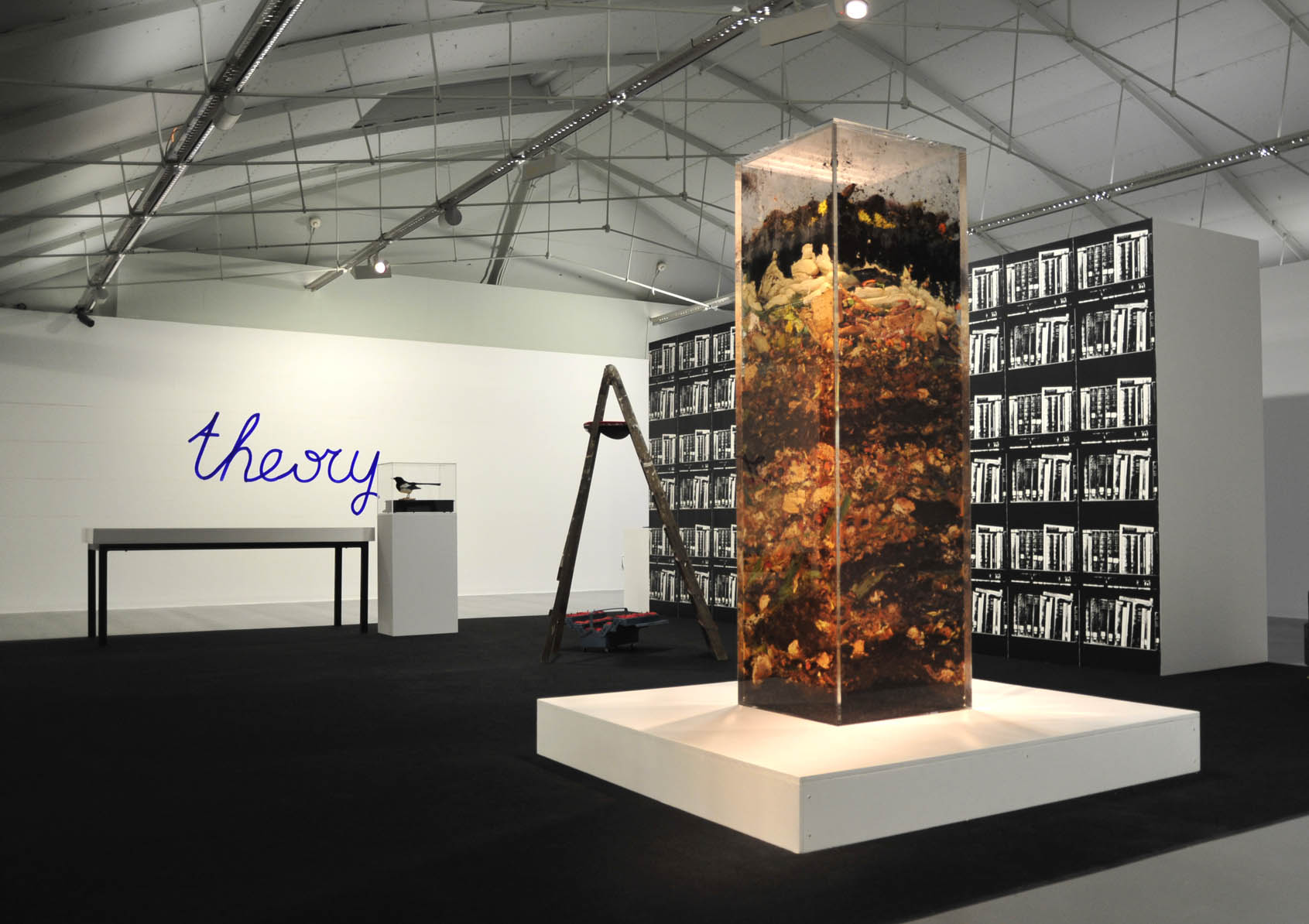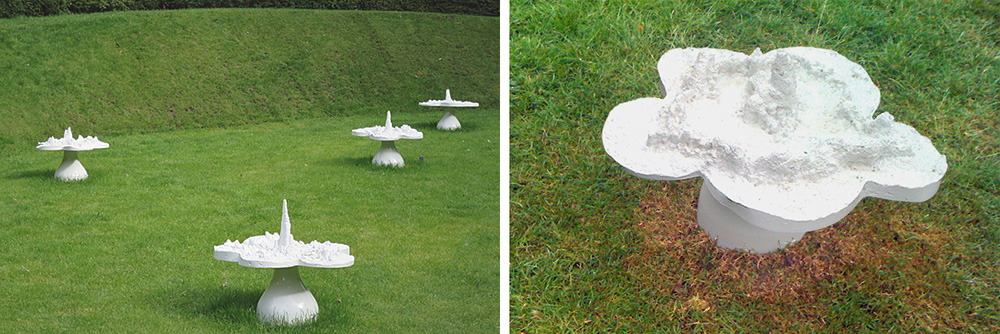HELEN CHADWICK REMEMBERED

Though this is the ‘Newsletter’ I can’t claim that what follows is ‘news’. Rather, it’s a recollection, via projects of Helen Chadwick (H.C.), of the very old, the ancient even, as it may bear on ‘our’ disaster-mired ‘present’ – the ‘now’. Her pieces pose pertinent questions about what our current models of ‘life’ and its ‘treatment’ (of our mutable bodies) might be passing over or repressing. The technoscientific disciplines we ‘live’ by are terrific at exploring the ‘how’ questions about ‘life’s’ embodying processes, but are constitutionally speechless about ‘what life is or might be(come)’. H.C. exposes the latter as still in question for art.
Her prescience bears on ‘life’s’ – our – present trebly pandemicised disaster. Chronically, our survival is threatened by global climate devastation. Acutely, another ‘life-form’ and its variants are laying ‘our life-form’ to waste. And these, in turn, are emergent off-springs generated through the insane double helix machinations of the embracing capital-and-technoscience un-life-form pandemic.
But H.C. felt out a very different pan demos. She re-figured a global ‘all of us’ enfolded within ‘life-as-wasting’. She offered (our) ‘embodiment’ ̶ its energised mutable, unstill animality – as an irremediable wasting-way. Her projects imaginatively exposed ‘life’s’ (and thus art’s) indissoluble intertwinement with ‘waste’ and ‘vastness’. We emerge from her projects as constitutionally condemned wasters: ‘living’ is, unavoidably excessive, always already wasting away.
Our entire ‘becoming’ (from breathing-pulsing on…) entails wasting. Derived from the Latin verb vastare , ‘to waste’ intertwines wasting with the ‘vast’. It points both to the ‘beyond’s’ vast nothingness-to-infinity, but also to the groundless ‘elsewhere’ of the arts’ interruptions of everyday life’s flow-away. It’s the very ‘now’ where, routinely, ‘getting and spending, we lay waste our powers’ (Wordsworth).
For H.C., the potential of our animality’s energised embodiment, its special quality, was its permeation by mutability-as-wasting. The exploratory celebration of this became her focus. She thus recalls our arts’ origins in the Greeks’ performative celebration of ‘life’ as a tragic-comedic tension. And the comedic surfaces slyly everywhere across her projects; wasting-away and its by-products (us…) provide endless punning materials.
Making-for-art engages this tension as it attempts its break out of the everyday via its interruptive cut in the mutable ‘present’. Mallarmé marks this slit, art’s site, as ’the place where nothing takes place but the place; it’s where making hazards its little nothings, one-offs, unknowable in advance, waste matters superfluous to the needs of getting-spending’s productive economy. It’s there too that H.C. exposed the living-wasting tension that fired her elsewhere-charge.
Across a range of gests she constituted ‘living’s’ dependence on nutritive digestion as a ‘site’ for paradoxical delight. ‘Life’s’ out-of-sight processes (including imagination-as-digestion) challenged her to realise visibly and wryly celebrate these unconscious but also ‘felt’ processes. She performed this in ‘Carcass’ (one element in ‘Of Mutability’ (1986), an installation in London’s I.C.A., an institution founded to promote and protect contemporary art…). Carcasses have recurred in art throughout Christian iconography and contemporary painting (Rembrandt, Soutine, Bacon, for example). But H.C. figured the carcass-as-bare-processor very differently.
Filling a transparent sealed box-tower with waste organic matter (food preparation’s domestic compost), she exposed the digestive dependency of whatever-organicity. Imagining it would be like ‘an emblem of death and decay’, she hadn’t anticipated the vitrine’s internal ‘life’ of fermentation .1 The vitrine’s self-energising ‘content’ – bacterial activity – dynamised its transitions, through solid to liquid, rising, falling, and leaching, into its visibly self-vivifying subject.
The lively box tower (a surrogate for the artist herself) was a self-activating, self-processing performance that began to leach strongly-scented elements of its rotting load spreading inexorably throughout the gallery. Devastatingly this instigated its death as ‘art’. Deemed offensive by the decorum police (gallery management) it was removed. It thus became ‘just’ waste. Simultaneously this laid waste the gallery’s raison d’être (art’s promotion/protection). Authority couldn’t stomach an art bursting with life.
Censorship: revelation of the absolute gap between the desire energising art’s performance and the interests that manage art’s appearance and representation. Outside the I.C.A. on The Mall similar smells remain unprovocative and uncensored. The endless droppings of military and royal horses (stabled hard-by) remain matters beyond concern. Quirkily, on this occasion, art, despite its defining weakness, became actively offensive in its very patency.
In other projects H.C. revealed the intrinsic ties between embodiment’s wasting processes and art’s performative potential. In ‘Piss Flowers’ (1991-2) she took the universal wasting-function of urination and, via the physico-chemical interaction of warm urine with ice-cold snow, she created a series of flower-form sculptures in bronze and cellulose lacquer. By combining the internally separate energies of digestion and art-full imagination she generated an external collaborative performance suturing the nature – culture split. The edges of the emergent white casts were shaped to mime flower petals, while their surface contours revealed the crystalline protuberances as relics of the urine’s action. Sexual organs – pistil and style – were naturally implied in the snow’s urine-rinsed remnants. These white hermaphrodites seemed to stand as seriously comic displays of the apparent inescapable purity of waste.

‘Cacao’ (1994), a gallery installation, promised gustatory delight-to-come. A large vat of simmering bubbling chocolate suffused the atmosphere with chocolate’s seductive smell. The gallery became a nascent kitchen or (sickeningly) sweet factory, perhaps offering art as a sweet nutrition? Yet its nothing-but-simmering condemned it to hang permanently between preparation (‘always already’) and consumption (‘not yet’) – art as inescapably sensually felt, but simultaneously nothing but mediation, a hanging back, forever aloof from ingestion. Its consumption of real energy was entirely in the service of a process without a product. As only ‘potential’, it took on wasting – it performed ‘art’ as endless wasting away. And we knew all too well that, post-exhibition, it would (just as its colour, its movement, and its name foretold) be sewer-bound. ‘Cacao’ seeds chocolate, yes, but also caca (French for stool, shit), cacare (Latin for ‘to defile with excrement’), and cacophony (whose caco is a prefix for the bad/diseased/wild). With ‘Cacao’s’ Ubuesque gesture H.C.’s installation turns back palindromically through itself, leaving us and itself suspended between different wasting matters, matters that will never cease to matter, even as laughing matters, for us.
What she cast down before us in these free-standing, floor-dependent, but groundless installations, was the felt-out ‘improper’ – the wasting – that constitutes we mutables’ passing performance. She reminds us that in life-as-pandemic we are its property rather than the other way round. This may be (a slight) consolation, but is it news?
Michael Phillipson LG, 2021
michaelphillipson-arts.co.uk
1. H.C. interviewed by Mark Haworth-Booth in ‘Stilled Lives’, Portfolio gallery, Edinburgh, 1996.
[The latter paragraphs of the above were adapted from Text 14 – ‘To Risk’ – in ‘Art’s Plight’ at michaelphillipson-arts.co.uk ]
[fvplayer src=”https://www.youtube.com/embed/5WrmA8UdqAs” width=”800″]
(video extract) Helen Chadwick making Carcass, 1986
